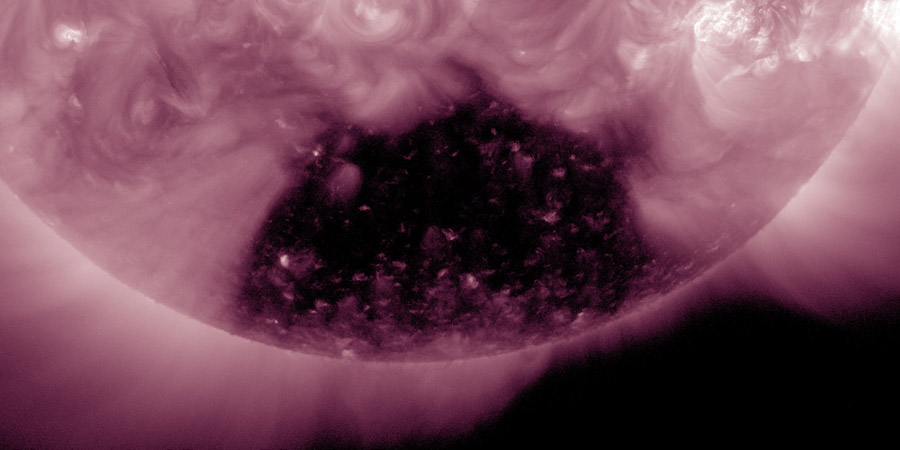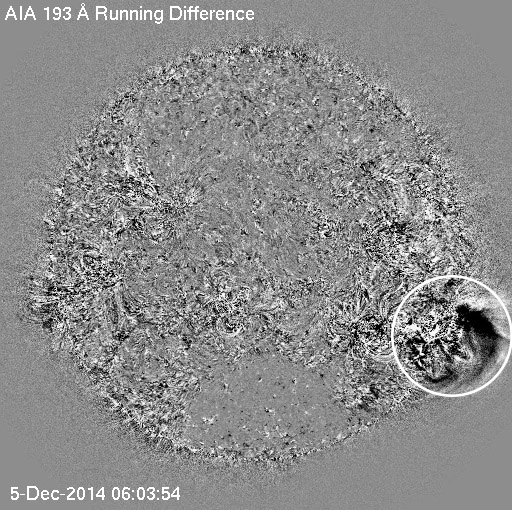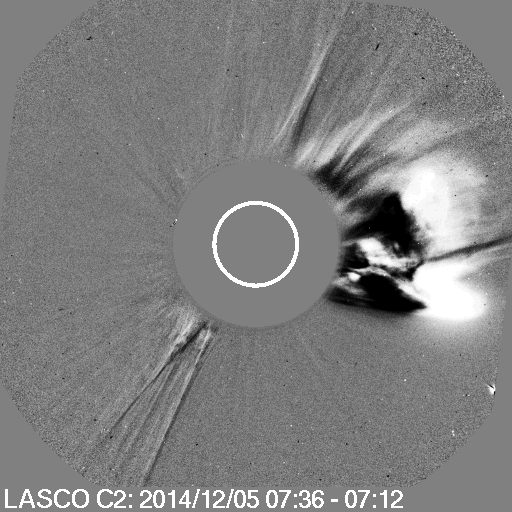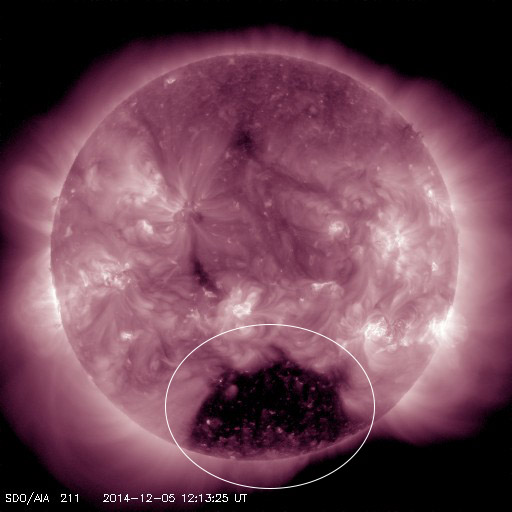High solar activity, coronal hole
Friday, 5 December 2014 12:54 UTC

Solar activity increased to high levels yesterday as sunspot region 2222 produced an M6.1 solar flare at 18:25 UTC. This was actually one of two M-class solar flares yesterday as the same same region produced an M1.3 solar flare at 08:56 UTC on the same day. Just now as we were writing this news article, sunspot region 2222 released yet another M-class solar flare: M1.5 at 12:25 UTC. Did any of these eruptions launch a coronal mass ejection? We are keeping our attention on the Sun and another solar feature you can't miss right now is a large and dark coronal hole which is located on the Sun's southern hemisphere and directly facing earth right now. Will this coronal hole bring us enhanced solar wind conditions and thus aurora in the coming days?
4 December M-class solar flares
Solar activity increased to high levels yesterday as sunspot region 2222 produced an M1.3 (R1-minor) solar flare at 08:56 UTC and an M6.1 (R2-moderate) solar flare at 18:25 UTC.
Moderately strong M1.31 solar #flare from #sunspot region 12222 - Follow live on http://t.co/8JIfkaXUPc pic.twitter.com/9LCrijrbxN
— SpaceWeatherLive (@_SpaceWeather_) 4 december 2014
Strong M6.16 solar #flare from #sunspot region 12222 - Follow live on http://t.co/8JIfkaXUPc pic.twitter.com/bWkRpbZiBT
— SpaceWeatherLive (@_SpaceWeather_) 4 december 2014
Unfortunately we have to conclude that after taking a look at the LASCO coronagraph imagery that none of these M-class solar flares released a coronal mass ejection. As a matter of fact, these solar flares looked very similar to the X-class solar flares of giant sunspot region 2192 which also failed to launch any coronal mass ejections.
5 December - M1.5 solar flare
The M1.5 solar flare from sunspot region 2222 that peaked just moments ago at 12:25 UTC again looks to be confined and no coronal signatures can be seen on SDO/AIA imagery that would suggest the launch of a coronal mass ejection. We will wait for SOHO/LASCO coronagraph imagery to confirm but it is highly likely that this group again failed to launch a coronal mass ejection.
Moderately strong M1.55 solar #flare from #sunspot region 12222 - Follow live on http://t.co/8JIfkaXUPc pic.twitter.com/ntz2tIUmc8
— SpaceWeatherLive (@_SpaceWeather_) 5 december 2014
Apart from these M-class solar flares there was also a C1.8 (yes, C1.8) solar flare from sunspot region 2226 near the west limb which was much more violent and eruptive than all the M-class solar flares of the past few days. Type II and IV radio sweeps as well as coronal dimming were associated with this C1 solar flare and a coronal mass ejection was launched that was directed well west and away from earth.


ALERT: Type II Radio Emission Begin Time: 2014 Dec 05 0601 UTC Estimated Velocity: 810 km/s
ALERT: Type IV Radio Emission Begin Time: 2014 Dec 05 0623 UTC
Coronal hole
A large, dark and potentially powerful coronal hole located on the Sun's southern hemisphere is now facing Earth. This coronal hole is not located near the Sun's equator and thus not directly facing Earth but it is still possible that solar wind streaming from this coronal hole will arrive at Earth in the next 24 to 48 hours. Keep this in mind if you are on a high latitude locations as enhanced auroral conditions are possible in the days ahead. Solar wind speeds are expected to peak at or even above 600km/s according to NOAA's ENLIL solar wind model.

Images: NASA SDO, LMSAL, NASA/ESA SOHO.
Thank you for reading this article! Did you have any trouble with the technical terms used in this article? Our help section is the place to be where you can find in-depth articles, a FAQ and a list with common abbreviations. Still puzzled? Just post on our forum where we will help you the best we can!
Latest news
Latest forum messages
Support SpaceWeatherLive.com!
A lot of people come to SpaceWeatherLive to follow the Sun's activity or if there is aurora to be seen, but with more traffic comes higher server costs. Consider a donation if you enjoy SpaceWeatherLive so we can keep the website online!

Space weather facts
| Last X-flare | 2025/03/28 | X1.1 |
| Last M-flare | 2025/04/01 | M2.4 |
| Last geomagnetic storm | 2025/03/27 | Kp5 (G1) |
| Spotless days | |
|---|---|
| Last spotless day | 2022/06/08 |
| Monthly mean Sunspot Number | |
|---|---|
| February 2025 | 154.6 +17.6 |
| April 2025 | 147 -7.6 |
| Last 30 days | 128.8 -21.8 |


